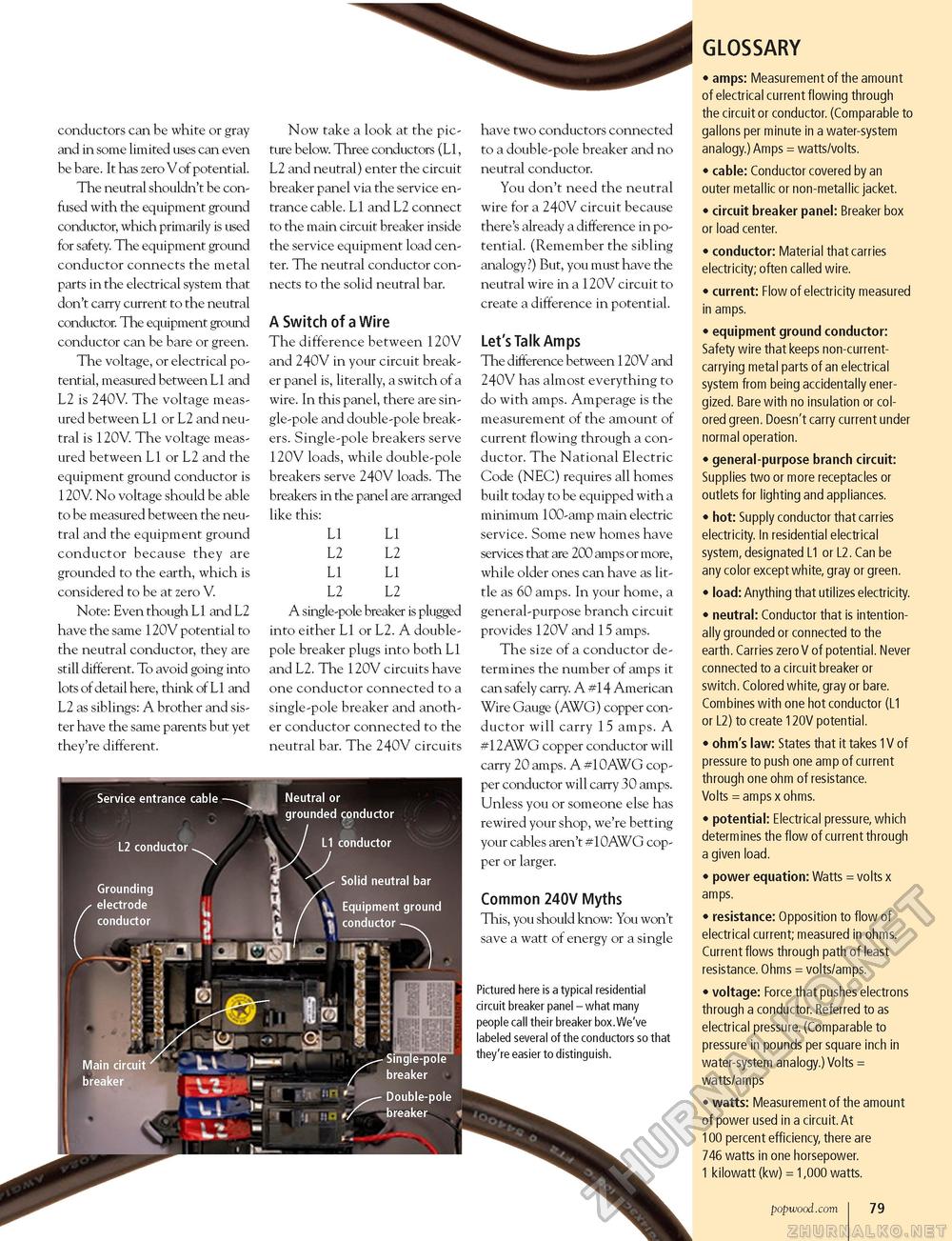Popular Woodworking 2003-11 № 137, страница 80
GLOSSARY conductors can be white or gray and in some limited uses can even be bare. It has zero Vof potential. The neutral shouldn't be confused with the equipment ground conductor, which primarily is used for safety. The equipment ground conductor connects the metal parts in the electrical system that don't carry current to the neutral conductor. The equipment ground conductor can be bare or green. The voltage, or electrical potential, measured between L1 and L2 is 240V. The voltage measured between L1 or L2 and neutral is 120V. The voltage measured between L1 or L2 and the equipment ground conductor is 120 V. No voltage should be able to be measured between the neutral and the equipment ground conductor because they are grounded to the earth, which is considered to be at zero V. Note: Even though L1 and L2 have the same 120 V potential to the neutral conductor, they are still different. To avoid going into lots of detail here, think of L1 and L2 as siblings: A brother and sister have the same parents but yet they're different. Now take a look at the picture below. Three conductors (L1, L2 and neutral) enter the circuit breaker panel via the service entrance cable. L1 and L2 connect to the main circuit breaker inside the service equipment load center. The neutral conductor connects to the solid neutral bar. A Switch of a Wire The difference between 120 V and 240V in your circuit breaker panel is, literally, a switch of a wire. In this panel, there are single-pole and double-pole breakers. Single-pole breakers serve 120V loads, while double-pole breakers serve 240V loads. The breakers in the panel are arranged like this: L1 L1 L2 L2 L1 L1 L2 L2 A single-pole breaker is plugged into either L1 or L2. A double-pole breaker plugs into both L1 and L2. The 120V circuits have one conductor connected to a single-pole breaker and another conductor connected to the neutral bar. The 240V circuits Service entrance cable ■ L2 conductor - Grounding electrode conductor ! Neutral or grounded conductor v!> L1 conductor Solid neutral bar Equipment ground conductor have two conductors connected to a double-pole breaker and no neutral conductor. You don't need the neutral wire for a 240V circuit because there's already a difference in potential. (Remember the sibling analogy?) But, you must have the neutral wire in a 120 V circuit to create a difference in potential. Let's Talk Amps The difference between 120V and 240V has almost everything to do with amps. Amperage is the measurement of the amount of current flowing through a conductor. The National Electric Code (NEC) requires all homes built today to be equipped with a minimum 100-amp main electric service. Some new homes have services that are 200 amps or more, while older ones can have as little as 60 amps. In your home, a general-purpose branch circuit provides 120V and 15 amps. The size of a conductor determines the number of amps it can safely carry. A #14 American Wire Gauge (AWG) copper conductor will carry 15 amps. A #12AWG copper conductor will carry 20 amps. A #10AWG copper conductor will carry 30 amps. Unless you or someone else has rewired your shop, we're betting your cables aren't #10AWG copper or larger. Common 240V Myths This, you should know: You won't save a watt of energy or a single Pictured here is a typical residential circuit breaker panel - what many people call their breaker box.We've labeled several of the conductors so that they're easier to distinguish. • amps: Measurement of the amount of electrical current flowing through the circuit or conductor. (Comparable to gallons per minute in a water-system analogy.) Amps = watts/volts. • cable: Conductor covered by an outer metallic or non-metallic jacket. • circuit breaker panel: Breaker box or load center. • conductor: Material that carries electricity; often called wire. • current: Flow of electricity measured in amps. • equipment ground conductor: Safety wire that keeps non-current-carrying metal parts of an electrical system from being accidentally energized. Bare with no insulation or colored green. Doesn't carry current under normal operation. • general-purpose branch circuit: Supplies two or more receptacles or outlets for lighting and appliances. • hot: Supply conductor that carries electricity. In residential electrical system, designated L1 or L2. Can be any color except white, gray or green. • load: Anything that utilizes electricity. • neutral: Conductor that is intentionally grounded or connected to the earth. Carries zero V of potential. Never connected to a circuit breaker or switch. Colored white, gray or bare. Combines with one hot conductor (L1 or L2) to create 120V potential. • ohm's law: States that it takes 1V of pressure to push one amp of current through one ohm of resistance. Volts = amps x ohms. • potential: Electrical pressure, which determines the flow of current through a given load. • power equation: Watts = volts x amps. • resistance: Opposition to flow of electrical current; measured in ohms. Current flows through path of least resistance. Ohms = volts/amps. • voltage: Force that pushes electrons through a conductor. Referred to as electrical pressure. (Comparable to pressure in pounds per square inch in water-system analogy.) Volts = watts/amps • watts: Measurement of the amount of power used in a circuit. At 100 percent efficiency, there are 746 watts in one horsepower. 1 kilowatt (kw) = 1,000 watts. popwood.com 79 |








